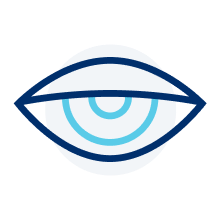

Despite being a well-characterised autoimmune disease, MG is rare, and at disease onset – which can occur at any age – patients present with highly heterogeneous clinical manifestations (including focal or generalised weakness with varying disease pathophysiology) that often change in nature and severity over time.2,3
Many symptoms of MG may also overlap with a number of other conditions such as thyroid disorders or other muscle diseases.3 Permanent muscle damage rarely occurs in patients with MG,4 so healthcare professionals unfamiliar with the disease may not consider an MG diagnosis for patients whose muscle weakness from the previous day has resolved the next morning.5
Together, these features can make the diagnosis of MG uniquely challenging.6,7
Patients with MG may experience diagnostic delays of several months or even years.7,8
MG is often misdiagnosed in the elderly, as symptoms such as dysphagia, dysarthria or fatigue may be attributed to other causes that can be common in this age group.5,7



Anti-AChR autoantibodies
Since the majority of patients with MG (about 80–85%) harbour autoantibodies against the acetylcholine
receptor (AChR),1,2,4,10 serum testing for these pathogenic autoantibodies is the first recommended
diagnostic investigation when MG is suspected.2,10–12
- The most widely used method for the detection of anti-AChR antibodies has been the radioimmunoprecipitation assay (RIPA), due to its high specificity (about 99%) and high sensitivity (about 85% in gMG and 50% in ocular MG).2 Modifications of the standard RIPA have been developed to increase the sensitivity compared to the standard RIPA.2
- Other assays – such as enzyme-linked immunosorbent assays (ELISAs), radiological assays and a fluorescence immunoprecipitation assay (FIPA) – have also been developed, though they tend not to reach the sensitivity of the standard RIPA.2
- It has been reported that cell-based assays (CBAs) can detect anti-AChR antibodies that are not detectable by RIPA, hence patients who are reported as anti-AChR seronegative with RIPA may be identified as anti-AChR seropositive with CBAs.2 It has also been reported however that CBAs were not able to detect anti-AChR antibodies in patients who were found to have very low but positive titres with standard RIPA.2
Anti-MuSK autoantibodies
In instances where patients are seronegative for anti-AChR antibodies, screening for antibodies against muscle-specific kinase (MuSK) is also recommended; these are present in about 6–8% of patients with MG.2,12
- RIPA is routinely used to detect anti-MuSK antibodies.2 An alternative method with increased sensitivity includes a step where the samples are concentrated by affinity chromatography before performing the RIPA.2
- ELISAs are also commercially available for the detection of anti-MuSK antibodies, but are less commonly used.2
- FIPA seems promising and has been reported to have the same sensitivity as RIPA for anti-MuSK antibody detection.2
- CBAs have also been developed and were able to detect anti-MuSK antibodies in sera of patients who were identified as seronegative with RIPA.2
Anti-LRP4 autoantibodies
Identification of antibodies against low-density lipoprotein receptor-related protein 4 (LRP4) – a more
recently identified diagnostic biomarker of MG – may also have clinical utility in the diagnostic workup of MG
in supporting disease subtype classification.10,12,13 At least 2% of patients with MG have detectable
anti-LRP4 autoantibodies, though such estimates vary among studies and geographic regions.2,12
- Several assays have been used to detect anti-LRP4 antibodies, including RIPA, ELISA and CBAs.2
- RNS uses a slow rate of repetitive electrical stimulation (2–5 Hz) to examine decline in motor response (the study is positive if the motor response declines by more than 10%).3 In patients with MG crisis, RNS frequency is often abnormal.13
- SF-EMG assesses the so-called neuromuscular “jitter” during voluntary muscle contraction and is highly sensitive for MG in more than 90% of patients following examination of limb and facial muscles.13
Pharmacologic tests assessing the clinical response to acetylcholinesterase (AChE) inhibitors are recommended as confirmatory tests for MG diagnoses.11,12
In patients seropositive for anti-MuSK antibodies (or patients with suspected MuSK MG), it has been suggested not to perform the edrophonium test, as it may worsen patients’ weakness.12
Expert opinion and local guidelines regarding the use of the edrophonium and other pharmacologic tests – such as neostigmine – differ among countries and should be considered when deciding on the diagnostic workup for MG.12

